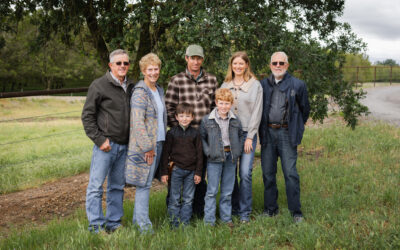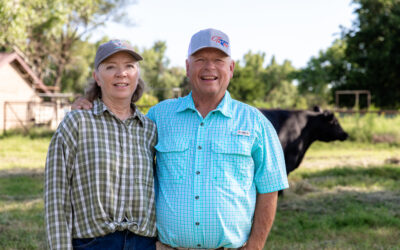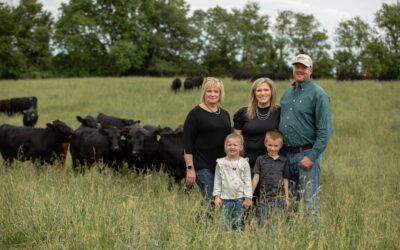
Cattle feeding chat builds bridges
Kansas brothers address beef marketers
by Miranda Reiman
When it’s just not possible to bring 600 people from across the globe to the feedyard, the next best thing is to bring a little of that Herington, Kan., family operation to them.
Cattle feeders Shane and Shawn Tiffany took the stage during educational sessions at last month’s Certified Angus Beef ® (CAB®) brand annual conference in Tucson, Ariz. The brothers gave foodservice and retail professionals a glimpse of life in a feedyard, often one of the most misunderstood parts of the beef community.
“It gives us an opportunity in our supply chain to bring those calves together from different genetics, different environments, different weights, shapes and size, born at different times – and create uniformity,” said Mark McCully, CAB vice president for supply during their introduction. “It allows us, as a beef supply chain, to have a 52-week supply of marketable finished cattle for your business.”
The Tiffanys have an open-door business model. They’re happy to talk about any part of the feedyard, they said, so they started at the beginning.
“Shawn and I literally grew up there,” said Shane. Their dad managed the feedyard for 14 years, and as boys they started out washing waterers and cleaning “boot [grain-receiving] pits” in the mill. “There was no such thing as a snow day. When school was cancelled, you went to work.”
Then they both went to college and on to other careers before forming a partnership to buy what is now the 14,000-head Tiffany Cattle Company.
“We took the chance and we jumped in,” Shane said. “The last nine years have been a whirlwind and it’s been a fun ride, but really we’ve just been incredibly blessed as we’ve grown the business.”
They gave a backdrop for the 45-minute conversation by explaining the typical schedule and chores at the yard.
“We’re in our office chairs by six in the morning. We expect the feed trucks to be rolling and dropping feed in the bunks before 7 a.m.,” Shawn said. “Cowboys are out saddling their horses in the dark and getting ready to go inspect every single animal in the yard, every day, for any health issues that may arise.”
They talked about their customers and the quality animals they receive into the yard.

“We’re 99% customer-owned cattle, so we provide a service for our customers that own the cattle. So think of a bed and breakfast,” Shawn said. “We sell food and rent a room.”
The chefs, beef marketers and others had a chance to text in questions for the cattlemen to answer live. Inquiries ranged from the transition to grain from forage and defining “feed conversions” to the kind of legacy they wanted to leave and future challenges.
“Your focus is pretty narrow when you’re young and broke and you’re trying to get a business off the ground,” Shawn said. “The goal is to stay in business until tomorrow.”
Now, there are eight kids that make up the next generation. They said that forces them to look longer-term, and makes them more determined than ever to share their story.
“The ruminant animal has the wonderful ability to take low-quality proteins, such as grass or corn silage and produce some extremely high-quality protein products that we can consume,” Shawn said, noting that most people just want to learn more about that process.
“If somebody will give you the time to explain your story and why you do what you do and how you do it, every single time people go away with a better feeling and better understanding of our industry,” he said.
The men and their wives spent the three-day conference interacting with people from very different geographies and diverse backgrounds.
“The moment we got off the stage, the rest of the weekend, we were constantly talking to somebody,” Shawn said. They chatted about cattle and everything in between, from grinding hamburger in San Diego to cutting steaks in Toronto. “There were just some great conversations with people who are from a considerably different segment of our industry, but are every bit as passionate about it as we are.”
To see more from the CAB annual conference, watch this special edition of “The Angus Report”: http://cab.info/2qx.
You may also like
Legacy in the Golden Land
On a quiet stretch of Northern California rangeland, a different story unfolds. The Borror family’s legacy modestly speaks through the cattle they raise, the ground they steward. The generations who’ve made a life here demonstrate commitment to doing things right, even when no one is watching.
Helping Hands, Helping Herds
“When I die, I want to come back as one of your cows,” murmurs a friend to Steve Zybach. Full to the brim from an alfalfa ration every day, bountiful fields of lovegrass stretched out across the Texas Panhandle—and owners who leave no ounce of cattle care up for question. The Zybachs’ motivation for this level of dedication to their Angus cattle is simply love.
An Ambassador for All
Joanie, with daughter Lindsey and her husband, Adam Hall, raise registered Angus cattle with two primary goals: producing high-quality seedstock that perform well in a wide variety of environments and ensuring end-user satisfaction. Those goals tie everything together, from promoting Angus to other producers to sharing their story with CAB partners and beef consumers.



